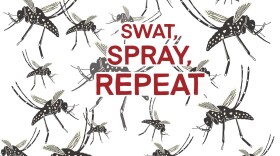-
As if our native mosquitoes weren’t pesky enough, we humans have imported some of the most invasive mosquito species to the U.S., bringing with them painful and debilitating diseases. Is there a human solution to this human-caused problem? Or are we destined to see history repeat itself, as we try (again and again) to outwit the deadliest animal on the planet?
-
Worst. Marine. Invasion. Ever. Prized as pets for their mesmerizing beauty, an aquarium keeper’s dream has become an environmental nightmare as legions of venomous, voracious lionfish are now guzzling up fish and further endangering coral reefs throughout the Atlantic, Caribbean and Gulf of Mexico. Researchers, inventors, divers and fishers are urgently trying to find new ways to stem the tide of these undersea marauders.
-
Beyond the hype about Pablo Escobar’s cocaine hippos, the real story of what’s happening in Colombia’s Rio Magdalena is surprising and complex. Some look on these hungry herbivores with affection and admiration, others fear their aggressive attitude and huge ecological footprint. Follow these unlikely invaders from Africa to Colombia with a possible layover in…Louisiana?
-
Invasive crayfish species are spreading throughout North Carolina, which is bad news for freshwater ecosystems.
-
Argentine black and white tegus can regulate their body temperature. This could help them invade as far north as North Carolina.
-
Tegus are armed with a metabolic superpower and a powerful appetite for eggs, but they’re also easily domesticated, making them both beloved family pets and unwelcome hungry pests. Throughout the South, these giant lizards are raising eyebrows, breaking hearts and launching lawsuits.
-
Lionfish and hippos and tegus, oh my! CREEP is back with a new season of discovery about species that are creating a world of new problems in new parts of the world. New episodes coming July 26th.
-
A population of an invasive fly from Asia has been discovered in North Carolina, confirming a prediction from agriculture experts that it was only a matter of time before the potentially destructive pest reached the state.
-
Bradford pears and 24 other ornamental trees were developed from Callery pears — a species brought to America a century ago to save ravaged pear orchards. Now, their invasive descendants have been reported in more than 30 states.
-
Rats have been hitching a ride with humans around the globe for so long, it’s easy to forget that in most places they are an invasive species. These clever, voracious vermin have staked their claim on cities across six continents, but in some parts of the world, there’s a push to reclaim key places from rats and rebuild fractured native ecosystems. | Support CREEP with a donation at wunc.org/give.
Play Live Radio
Next Up:
0:00
0:00
Available On Air Stations









